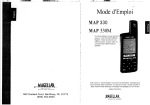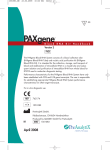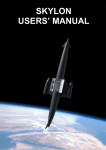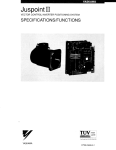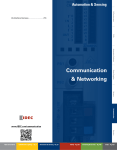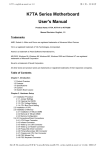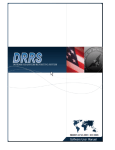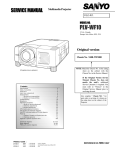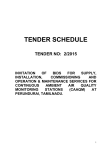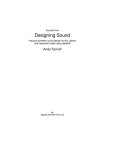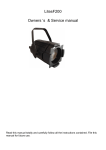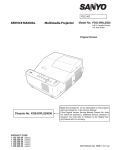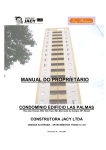Download Constraints on Electrical Power System Design From IPS Operation
Transcript
1122 IEPC-97-184 CONSTRAINTS ON ELECTRICAL POWER SYSTEM DESIGN FROM IPS OPERATION L. Croci, P. Galantini, A. Trivulzio FIAR S.p.A, Space Division - a Fiiccanica company Via Montefeltro, 8 - 20126 MILAN0 (I) tel. (++39) (2) 35790.1 - fax (++39) (2) 33400981 - E-mail: [email protected] H. Bassner Daimler-Benz Aerospace AG, Space Infrastructure Postfach 801168 - 81663 MUNICH, Germany tel. (49) (89) 60723126 - fax (++49) (89) 60725070 ABSTRACT Ion Propulsion Systems (IPS), like the Radiofrequency Ion Thrusters Assembly (RITA) from DASA, are now at the threshold of application on commercial satellites and appear to be a very attractive alternative to the chemical propulsion systems to perform the North-South Station Keeping (NSSK) manoeuvres of geostationary (GEO) satellites as well as to perform orbit raising manouvres. RITA IPSs are available in several configurations from 15 to 200 mN thrust levels and are characterised by a large throttling capabilities to adjust the thrust level to meet the optimum combination of operating time and Electrical Power System (EPS) load during the different mission phases. Starting from the operational characteristics in terms of electric power demand, daily switching cycle and operating time of the different RITAs, the influence of the relevant requirements over the electrical power system (EPS) characteristics is evaluated, with particular consideration for the energy source sizing. A trade-off is carried out between the supply of the IPS power demand at beginning of life either via the solar generator or via the spacecraft batteries. The increased number of battery charge/discharge cycles is also considered versus battery expected lifetime, battery charge rates and battery charge regulator configuration. Main bus protection and thermal dissipation constraints are also discussed. The results of the above trade-off is then summan‘sed in defting the optimum configuration of an EPS sized to supply a GE0 satellite equipped with an IPS with the minimum overall mass. The specific design constraints are also highlighted. Plasma Thruster), RITAs, being characterised by a high specific impulse (Isp), allow significant propellant mass saving. Typical RITA advantages vs. arcject and SPT electric propulsions are shown in Figure 1.1 where the launch mass saving and the spacecraft (S/C) platform capability improvements are reported in applications where JPS is used for NSSK tasks in GE0 satellites. Additional S/C dry mass capability increase is expected to be gained replacing the apogee motor with ion thrusters of some hundreds of mN thrust level coupled a different GE0 transfer orbit (e.g. with supersynchronous transfer orbits). Am@ct SPT 100 RITA 10 EP Technology #or NSSK ~_r Figure 1.1 - *ical .dvantages of RZTA IPS To meet commercial market requirements, four RITA versions art available with thrust levels from 15 to 200 mN [Ref. 11. RITAIPS I Kev Words: Electric Propulsion, IPS, Ion Propulsion, RITA, EPS, NSSK, GE0 satellites “0ao4050ao rnfw w L-I 120 IAN) 140 16~ iao zoo ” MTA 10 WA 15 RITA la RITA 28 IS’S ME Power -e-----c -v- 1. INTRODUCTION Ion thrusters require electric energy to operate. When compared with the chemical systems or other electric propulsion systems like the arcject and SPT (Stationary I I 1 Figure 1.2 - RITA Ion Propulsion Systems One of the most interesting capability of the RITAs is the throttling performance associated to high specific Copyright 1997 by the Electric Rocket Propulsion Society. AU rights reserved. IEPC-97:184 impulse: with this capability the thrust level can be adjusted to meet the optimum combination of operating time and EPS load constraints during the different mission phases. Figure 1.2 provides the thrust level capability and Elated overall Main Bus (MB) power consumption of the planned RITA systems. Even if primarily designed for commercial GE0 satellites, RlTA lPSs can find application also in scientific, earth observation and planetary missions. However, IPS implementation is not a simple straightforward approach and requires accurate trade-off on the different subsystems of the spacecraft to analyse impacts and constraints. On the EPS, these constraints are function of several parameters like satellite mass, mission time, IPS thrust level and related power consumption, thruster allocation and AOCS strategy, needed to operate also during eclipse periods etc. 2. IPS OPERATIONAL CHARACTERISTICS IPS can be used on GE0 satellites to perform efficiently several tasks: l autonomous and smooth NSSK manoeuvres, with consequent improved antenna pointing accuracy, less frequent ranging operations and easier collocation of satellites; l efficient and fast satellite repositioning in orbit; l End-of-Life (EOL) de-orbiting; l orbit raising and final orbit circularisation with hybrid propulsion (chemical plus IPS) or full ion propulsion.; l East-West Station Keeping (EWSK) manoeuvres. The first major application of lPS on GE0 spacecraft’s is the replacement of chemical propulsion for NSSK tasks. NSSK manoeuvres are performed to compensate the required thrust velocity increment (47 m/s year) around the orbit’s nodes that occur at 90” and 270” positions of the orbit. Today the NSSK manoeuvres are executed about every 70 days and manually controlled from the ground staff. With IPS the NSSK manoeuvres are to be executed once or two times per day and can be done autonomously by the spacecraft itself. . Satellite Performances GE0 satellites are growing in mass, installed electrical power and mission lifetime as well. Table 2.1 provides the four satellite categories that have been considered, representing the largest GE0 satellites market expected in the future. Satellite Cat. 1 Cat. 2 Cat. 3 Cat. 4 BOLMassF ] 1,500 2,000 2500 3,000 Launch Mass k ] 2,430 3,240 4,050 4,840 EOL MB Power [w][l] 3,000 6,000 8,000 12,000 Mission Tie [ r.] 15 cc Overall minimum MB Power (P/L power + SM power + Batteries Charge power) Table 2.1- GE0 Satellite Main Pelfomances 1123 The launch masses reported assume chemical propulsion for apogee injection into GE0 orbit from geostationary transfer orbit @TO). A Fully regulated EPS, i.e. Main Bus (MB) voltage kept constant in both sunlight and eclipse conditions, has been considered. 2.2 IUTA Thrusters Allocation The ion thrusters for NSSK tasks can be allocated in the Anti-Earth configuration or in the more simple and efficient E/W configuration [Ref. 11. The Anti-Earth allocation is easily adaptable to existing S/C’s platforms while the JYW allocation is recommended for the platforms conceived for lPS operation since the beginning. 2.2.1 Anti-Earth accomodation for NSSK In the Anti-Earth configuration the thrusters are to be mounted on gimbals for alignment towards the spacecraft’s COG (Centre of Gravity); canting angle depends on satellite geometry, 45” towards N-S axis is a standard. A North thrust firing (at 90”) has to be followed by a South thruster firing (at 2700), in order to cancel the effects of the radial component of the thrust (eccentricity impact). Therefore the NSSK manoeuvre has to be executed twice a day with a constant period of 12 hours or every 36 hours. East-West accomodation for NSSK 2.2.2 In the E/W configuration the thrusters are to be operated in pair. No radial component have to be compensated, and only one firing per day can be done (North or South thrusters) but duration has to be doubled with respect to two operations per day. Therefore the NSSK manoeuvre is executed once a day but with a constant period of 24 hours or twice a day with a constant period of 12 hours. The canting angle versus the N/S-axis can be decreased to 3Y. Allocation for NSSK and Orbit Raising 2.2.3 Two possibility exists: l separate and different thrusters for the two tasks, or l single thruster for combined tasks. ln the Anti-Earth approach, mounting the thrusters on gimbals with large pointing capability makes possible to change the thrusters position to perform orbit raising or NSSK manoeuvres. For orbit raising, two or four thrusters have to be operated, depending on the power available; inclination with respect to the flight direction could be 10”. The payload is off during this phase and all power is availabe to feed the IPS. For NSSK manoeuvres, the thrusters will be brought into a position where the thrust vector pass through the COG of the satellite. One thruster is operated at a time, at reduced thrust level, if there are limitation on available power for IPS operation. The increased thrust available by operating two thrusters at the same time can be IEPC-97-184 usefully utilised during satellite repositioning, being the payload off during this phase. AOCS Operation IPS is normally operated 2.3 daily but time for orbit determination has to be allowed. A seven days AOCS cycle has been considered e.g. N/S correction every day except for the 7th day, dedicated to the orbit determination. Table 2.3.1 provides the IPS operating requirements for the two thrusters allocation arrangements. Longer sailing time, e.g. 14 or 28 days cycles, increases the number of IPS operating days, thus slightly increasing the system efficiency. EWSK manoeuvres are still operated with chemical thrusters; operation of lPS and chemical systems cannot be done contemporary. 1124 2.6 RITA Selection Vs Spacecraft Performances Based on the spacecraft’s performances identified in Table 2.1, the best application of the different RlTA versions is provided in Table 2.6.1. However, final selection has to be based on Customer trade-off since optimum solution from a technical point of view could be commercially less attractive when benefits from commonalities among the production are taken into consideration or, last but not least, lifetime demonstration required time is evaluated [Ref. 11. l’able 2.6.1 RITA Applications Vs Spacecraf Per$ormances 3. EPS SIZING WITHOUT IPS Table 2.3.1 - IPS Operating Constraints 2.4 RITA Redundancy Scheme Due to the beam grid geometry adopted and the use of a RF-field for the propellant ionisation, the RIT thrusters are characterised by a lifetime in excess of 20,000 hours for all versions of thrust levels. Consequently, considering a minimum lifetime qualification factor of 1.3, all mission requirements can be. met with a 2+2 thrusters redundancy scheme in both Anti-Earth and EtW configurations. 2.5 RITA Operation During Jklipses NSSK manoeuvres never take place during eclipses so that the solar array can always be used to power, at least partially, the RITA. In particular, the nodes for NSSK manoeuvres are six hours after or before eclipses. In the past, IPS operation during eclipse seasons (1.2 hours for 84 days a year) was avoided due to the maximum allowable battery stress and the large EPS oversize required to feed the IPS The ever increase of today GE0 satellite performances and the replacement of NiCd batteries with NiH2 type has resulted in: l increased available on-board power, . increased allowable batteries stress, and, therefore, new trade-offs have to be performed to quantify the impacts on EPS sizing if lPS has to be operated also during eclipses. Figure 3.1 shows a simplified block diagram of a fully regulated EPS. The following efficiencies/losses have been considered: Sk efficiency: 97% BCR efficiency: 90% BDR efficiency: 93% Ll - losses between S3R and SA: 3% L2 - losses between BCR/BDR and batteries: 2% K factor (battery charge rate efficiency coefficient): 1.05 Ll MRU _ Main&Is 1 SA IFigure 3. I - EPS Block Diagram The EOL SA power at Summer Solstice (SS) represents the minimum SA available power but the worst case for EPS sizing is represented by the Spring (Vernal) Equinox (VE) conditions when the SA must provide the power also to recharge the batteries. Therefore the EPS has been first sized at VE with the following constraints: l energy in eclipses provided by two batteries, l 75% nominal Batteries Depth of Discharge (DOD), l parallel batteries charge, charge rate C/15, l possibility to sequential batteries charge, charge rate c/10, IEPC-97-184 SA fitted with Si cells, no additional MB power load considered for IPS operation. The EPS main performances and the available MB power for lPS operation are provided in Table 3.1 and 3.2. l l Satellite MB Pm + PSM(w) MBPBC (w) TotalMBpwrCW) Battery En. (Wh) EOL SA pwr (W) -VB - ss BOL SA pwr (w) -VB - ss BOL MB pwr for IPS operation (w) -VB - ss BOL MB pwr for IPS operation (w) - VE - ss ~,&~,~: 10,860 1,140 12,000 19,064 15,664 15,269 Thrust Level 1,140 838 3.878 3,507 B’S operation for NSSK tasks is possible without impacts on EPS provided that the following conditions are met: ZPS operated only outside eclipse seasons l satellites classes and based on IPS operating cycle as described in 9 2.2.1.2.2.2 and 2.2.3. RlTA’s PSCU (Power Supply and Control Unit) electronics for Anti-Barth and FYW thrusters allocation require slightly different architectures to minimise overall mass and number of boxes still meeting failure tolerance requirements [Ref. 1,2]: As an example, the parameters for IPS operated only outside eclipse seasons and computed for a 2000 kg BOL satellite mass equipped with RlTA 10, 25 mN are provided in Table 4.1 here below. 12,754 12,433 EPS Sizing and available MB Powerfor IPS Operation (NSSK manoeuvres) l 1125 at SS the EOL batteries DOD during IPS operation must be 75% max.; the batteries must be fully recharged before a second lPS fmng occurs. 0 Canting Angle 45 z,‘,“: ,,:, Spacecraft(S/C)D~~ai“, ,‘,:,$:<:‘: : .;+;:!:, S/C Mass in GTO kg 3240 S/C Mass in GE0 (BOL) kg 2000 Mission Lifetime years 15 EOL VE Overall MB Power W 6000 C/IT Battery Charee Rate -. __ MBPIL- t SM Power I w 1 5430 571) MB Power for Batten, Charge I w I Min. Battery Energy (for DOD 75%) 1 wh 1 - _ 9532 h-417 I w I EOL Solar Arrav Power at VP __. I I w EOL Sob lr Arrav Power at SS ZPS operated also during eclipse seasons at SS and at VB the EOL batteries DOD during lPS operation must be 75% max.: at SS the batteries must be fully recharged before. a second lPS firing occurs; at VB the batteries must be fully recharged before an eclipse occurs, and last but not least the overall batteries stress must be within the operating limits of the battery cells. 4. IMPACTS OF NSSK IPS OPERATION The impacts of NSSK lPS operation on BPS have been evaluated for the RlTA configurations provided in Table 2.6.1; B/W accomodation has been analysed for RITA 10, 15 and 18 systems only, after considerations on available MB power versus number of operating thrusters at the same time and operating time constraints as well. All parameters relevant to NSSK IPS operation and power requirements have been computed for the four <cquircd Manoeuvre Duration hours 1 3.19 I > ..r . _ ~uanncarton racror 1.5 I I tequired Thruster Life Qualification ( hours 1 17290 <OL PO%&. &+&&e& @f+G I.p:” : ,“:,,;,;-,,l~~~,r.i ;‘“::..:i dB Power Available fm IPS I w .. I , 1 LB Pwr to be r_ _ ____ _, _________, 1 Wh dB Energy from Batteries for lPS {at&es DOD durin ,___ TPS nn~ratinn _r ___._-.. 1 4/n I” 1 Table 4.1 RITA IO, 25 mNfor GE0 NSSK Tasks RITA Operated Only Outside Eclipses &ICI d, 1 1309 12 72 ._1.,d IEPC-97-184 4.1 1126 RITA Operated Only Outside JMipses From a SA sizing point of view, all RITA confqgumtions evaluated can be handled by the EPS without any additional requirement in terms of electrical power or energy to be provided, if RITA is operated only outside eclipses, i.e. for 241 days/year. The batteries DOD at EOL is within the 13 to 33 % range. A C/15 batteries charge rate provides mom than 10% margin to achieve full batteries charge before another manoeuvre has to be executed. A typical batteries charge profile is shown in Figure 4.1.1. Zoo0 kg BOL, 15 Years Mission,C/15 Satteq Charge Rate IPS Operated Only Outside Edipoes (241 days/year) adjusting thrust level, if rcque&d 1 t $%O Figure 4.1.1 - Typical EOL Battery Charge Profile During RITA Operation Outside Eclipses (E/W Configuration) 4.2 RITA Operated Also During Eclipses Anti-Easih Thrusters Allocations All RITAs can be operated also during eclipses without any SA EOL power increase, with exception of Category 1 spacecraft were a 115 W SA increase is required. A typical batteries charge profile during eclipses is shown in Figure 4.2.1. 1500 kg SOL. 15 Years Mission Figure 4.2.1 - Typical EOL battery cycles during eclipse seosons (Anti-Eatth Contguration) B/W Thrusters Allocations (RITA IO, IS and I8 only) A slightly increase in the EOL SA power at VE is required as per Table 4.2.1 to operate the system also during eclipses. A typical batteries charge profile during eclipses for E/W thrusters allocation is shown in Figure 4.2.2. power is not available Table 4.2.1 Additional EOL SA Power Required with E/W Thrusters Allocation for RKA Operation Also During Eclipses 1500 kg SOL. 15 Years Mission IPS Operated Also During Eclipses (313 days/year) 44 Figure 4.2.2 - Typical EOL battery cycles during eclipse seasons (E/W Configuration) _ 4.3 IUTA Operated for Orbit Raising Tasks IPS application for orbit raising manoeuvres can be considered to save additional mass. If thrusters are dedicated to this task they can be mounted in fixed position and aligned versus the flight direction, or can be placed on gimbals to be used for both orbit raising and NSSK tasks. To avoid disturbances to the spacecraft, the thrusters have to be operated in pair(s). The high thrust level stability, the tine thrust level adjustment capability and the large throttling range associated to a high specific impulse make RITAs a suitable candidate for this tasks. The S/C’s payload is normally off in this phase of the mission, thermal connol has to be active to keep the equipmet within minimum temperature range and the IPS must be operated during sunlight conditions only and switched-off as soon as the satellite is entering into eclipse, being the batteries utilised for thermal control purpose only during this phase. Assuming that the required MB power is available, up to four thusters can be contemporary operated achieving up to a nominal thrust of 320 mN for RITA 18 and 800 mN for RlTA 26 system; 70/100 V MB voltages are recommended for this application. The throttling capability of RITAs allow thrust level reduction, increasing the time required to performed the task, in case EPS constraints impose less IPS power consumption. In case of one thruster failure at beginning of mission, only two thrusters are stil available to perform the task. IEPC-97-184 4.4 EPS Archim Impacts The following constraints have to be taken into account in selecting the EPS architecture: all SA-power has to be delivered to the MB; sequential batteries charge strategy should be avoided Main Regulation Unit (MRU) dissipation increases during sunlight operation; high power loads switch on/off response. No batteries charge via dedicated SA sections architecture has to be selected, being SA power dedicated to battery charge to be used also for IPS operation. Sequential batteries charge strategy in case of BCR failure imposes a complicated batteries management and therefore has to be avoided. Consequently, redundancy of BCR functions have to be implemented. This approach is already common on several EPS; if not, about 2 kg BPS mass increase has to be taken into account. Anyhow, in case of emergency conditions the IPS can be switchedoff and sequential batteries charge can be performed. During sunlight conditions some power has to be provided by the batteries for II’S operation during NSSK manoeuvres. Therefore, the MRU must be able to operate when power is provided by both S3R and BDR functions, with consequent increased unit dissipation. For better EPS and IPS optimisation a single bus EPS is highly recommended. 5. BATTERY STRESS RITA operation places additional stress and increased cycles on the batteries. This demand, which is repetitive over the life of the mission, imposes peak power requirements which will necessitate battery discharge during both sunlight and eclipse periods. The maximum stress is obviously reached at EOL, when the power available from the SA is reaching the minimum In order to maintain the batteries stress within the limits it could be necessary to increase the SA size. The expected NiHs batteries cycles are function of the DOD [Ref. 31. For 3 1% electrolyte concentration, the following cycles are expected: l 70,000 for 30% DOD; l 25,000 for 60% DOD; l 9,ooO for 90% DOD. In order to evaluate the overall batteries stress, the accumulated cycles x DOD over the lifetime is assumed not to exceed the value of 450,000 (a factor of 2 margin from a maximum of 900,000 “cycles x DOD” achievable with 90% DOD). For 15 years mission time the worst case computed overall batteries stress expressed as cyc1e.rx DOD are: l 002,000 for SIC Category 1; l <236,000 for SIC Category 2; l <193,000 for S/C Category 3; l <133,000 for S/C Category 4. 1127 On the above basis, the combined batteries stress due to eclipses and RITA operation are well within the allowable value and enough margin is available for the increased satellite in-orbit lifetime (e.g. 20 years). Therefore, no increase of the SA size has to be considered for IT’S operaton due to battery stress requirement. However, to achieve these performances, the guidelines mcomme&d by batteries manufacturers and, in particular, the optimum Charge and Discharge cycles operating temperatures have to be followed. 6. SOLAR ARRAY DEGRADATION The embarkment of IPS can produce additional power constraints on the SA due to: l additional SA degradation due to the ion beam; l additional SA degradation during transfer orbit manoeuvres due to the longer duration with respect to chemical propulsion. RITAs, as all gridded thrusters, are characterised by a low beam divergency (>90% of the energy concentrated into *12” beam width). Considering a minimum canting angle of 35” mspect to N/S axis, the evaluated additional solar array degradation is expected to be less than 1% for a 15 year mission, As concerns SA degradation due to longer permanence into low/medium orbits if orbit raising and final allocation manoeuvres are performed by IPS, the relevant amount is function of the selected transfer orbit and thrust level available to perform the orbit raising. Use of GaAs solar cells, which are more tolerant to radiations, reduce the impacts. 7. MB TRANSIENTS RESPONSE IPS on/off switching generates a very large load variation to the MB; this variation can cause the MB to go outside specified variation range, if not properly addressed in the design of the EPS or in the IPS implementation. In case of NSSK tasks, the power load variation can be in the order of 1.5-3 kW depending on the nominal thrust level and number of thrusters to be switched at the same time. In case of use of IPS for orbit raising, the value is much higher and can be in the order of 8-10 kW. RITAs have been designed to avoid large power load variations. In fact, a soft start-up is implemented and moreover it is possible to mitigate the MB load variations using the throttling capability function. All these operating modes are executed automatically by the PSCU of the thruster upon receipt of the on/off command or can be commnaded from ground. 8. MB PROTECTION To protect the MB from short circuits two alternatives exists: l fuses * EF (Electronic Fuses) or SSPC (Solid State Power Controllers) IEPC-97-184 Fuse protection is very popular, being very cheap, but high margin from nominal to actual value have to be taken and a MB voltage drop of some tens of ms have to be accepted before a fuse blow. Considering the in-rush current and the required derating rules of the different devices, fuses can be used efficiently for loads up to 15 A nominal. With a 50 V MB, the nominal IPS MB current is in the range of 11.6 to 16 A for the RITA 10 versions, 31 A for RITA 15 and SOA for the RITA 18. Therefore, fuses can be considered only for the RIT’A 10 version while EF or SSPC are mandatory for RITA 15 and RITA 18, unless specific design architectures are implemented in the IPS electronics [Ref. 21. EF or SSPC complexity are almost proportional to the rated current and therefore power dissipation and cost of a 32 A device is near twice the value of a 16 A device. In case of higher MB voltage i.e. 100 V, fuses are the favourite choice for all RlTAs. 9. EPS THERMAL ASPECTS IPS implementation requires additional S/C heat rejection capability due to: l dissipated power due to IPS; l additional dissipated power in the EPS. In fact, the MRU has to provide the additional power required by the IPS via SA and batteries when IPS is used for NSSK tasks. Figure 9.1 shows tbe power dissipated by the RITA and the additional power to be dissipated by the MRU as consequence of RITA operation. To reduce the MRU thermal constraints when RlTA 18 or RITA 26 are implemented, the thrust level can be reduced increasing tbe IPS operating time. Figure 9.1 Addirional S/C Thermal Rejection Requirements For orbit raising tasks, IPS is always operated via SA and therefore no additional constraints on MRU apply during this mission phase. 10.ESD CONSTRAINTS Electromagnetic interactions between plasma satellite structure occurs if charged ions arc emitted. and 1128 No additional precautions have to be taken with RITAs, since very few charged ions are emitted by the thruster, as measured and the flight test data from the EURECA experiment. 11. RITA ADVANTAGES To compare RITA versus other ion propulsion concepts, a design exercise similar to the one described before has been performed considering an IPS malised with SPT 100 thrusters whose main perfomrances are summarised in Table 11.1. ; :“il;u~~,~~~.~~~~~~,~~~: ,:.i:l;:~,:j:~~~~,.~~~~:~~~,~~~~~~; y,c Thrust Level 111 12 mN Isp 1560 s Beam Divergence G5” IPS required power 1555 w Expected thruster lifetime ~7,000 hours [I] 80 mN nominal, corrected for beam divergence Table II.1 - SPT 100 IPS Main Petionnances Comparing the results, the RITA systems provides the following advantages: in spite of tbe lower thrust to power consumption ratio with respect to SPT technology, no penalizations on EPS sizing is caused by RITA; the low beam divergence allows both Anti-Earth and E/W thrusters allocations with canting angle as low as 35” for RITA but not for SPT 100; RITA 10 requires only one half of tbe heat rejection capability increase compared to SPT 100, RITA 15 is similar to SPT 100; RITA does not generate ESD problems: very few charged ions are emitted and therefore no particular filters to decouple RITA’s PSCU and thruster are required. On the contrary. due to the special ionisation process and to the open extraction area, SPT emits ions with different exhaust velocities and filters have to be inserted to avoid conducted susceptibility problems [Ref. 4, 51. The filter losses have not been considered in the SPT required power consumption indicated here above; RITA’s soft start-up reduces power loads variations. With SPT, the MB load variation at switch-on is even amplified because 50% more power is required by SIT for some millisenconds with respect to normal power); the RITA large throttling capability associated to high specific impulse allows optimum combination of power consumption and operating time ratio; The RITA low beam divergence has negligible impacts on SA degradation. Recent data on SPT 100 thrusters indicates serious problem if 45” canting angle is used, due to direct impingement of the plume on the SA in certain orbital conditions [Ref. 5, 61. If IEPC-97-184 l cW a large canting angle has to be implemented with reduced benefits from tbe high thrust level; RITA long thruster lifetime: >20,000 hours expected. 12. SUMMARY Today GE0 commercial spacecraft can be equipped with RITA IPS operating also during the eclipse seasons without impacts in mrms of EPS energy source sizing, thanks to the increased available on-board electrical power with respect to previous spacecraft’sgenerations and due to availability of NiHr batteries. A combined assembly for NSSK manoeuvres and orbit raising tasks is possible, accomodating the thrusters on gimbals with high regulation angle, adjusting the thrust level according to the satellite mission phase if MB power constraints exists. Use of fuses for MB protection from short-circuits is possible in most of the cases, even if more sophisticated (and costly) EF or SSPC devices offers best performances in terms of protection and MB transients. The soft start-up implemented in the RITA power electronics generates a smooth MB voltage transient due to RITA on/off switching. No particular measures due to ESD phenomena have to be considered for RITA systems. The critical aspect of IPS implementation is represented by the additional S/C thermal rejection capability requested and in particular, the requirement for the MRU to provide contemporary power from SA and batteries. In case the IPS is implemented to reduce launch mass, this aspect has to be investigated with the available S/C thermal rejection margins at Winter Solstice. In case IPS is implemented to allow embarkment of more complex payload without increasing the launch mass, the available S/C capability increase is used partially to increase the payload performances and the rest to increase electric power availability and thermal rejection capability. In any case, to perform NSSK tasks, the selection of long life gridded ion thrusters like the RITA 10 systems reduces the additional power to be dissipated by the MRU. References 1. H. Trivulzio: Bassner, K. Bohnhoff, A. Commercialized Ion Propulsion For North/South Station Keeping Of Communication Satellites - 25th IEPC, 1997, Cleveland, Ohio 2. S. Arcisto, M. Gambarara, A Garutti, A. Trivulzio, A. Truffi, H. Bassner, H. Mtiller: Power Supply And Control Unit (PSCU) For Radio Frequency Ion Thrusters (RIT) - 2nd European Spacecraft Propulsion 1997, ESTEC, Conference, Noordwjik, The Netherlands 3. NiHz User Manual - Eagle-Picher Industries 1129 4. B. Thi&, G. Beaufi, H. De&q: SPT Electrical Module Development - 2nd European Spacecraft Propulsion Confenncc, 1997, ESTEC, Noordwjik, The Nethe&& 5. M. P. Burgasov et. al.: The Results Of Complex Work Concerning The Problem Of Electric-Rocket Thrusters Integration With Spacecd And Its Subsystems - 2nd European Spaacraft Propulsion Conference, 1997, ESTEC, Noordwjik, The Netherlad 6. J-F. Rousael, J. Bernatd: Numerical Simulation Of ILNhl&En viromnent, Sputtering And Contamination Of Satellite Due To Electric Propulsion - 2nd European Spaaxraft Repulsion Conference, 1997, ESTEC, Noordwjik, The Netherlands








